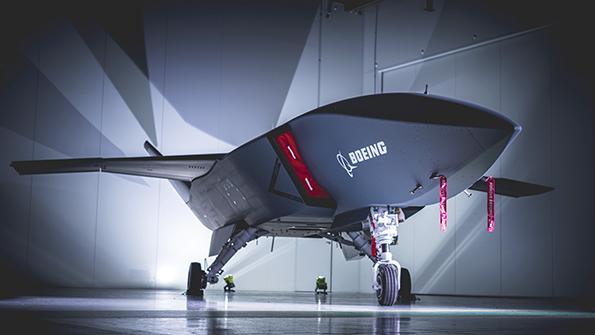
Boeing has rolled out its Airpower Teaming System (ATS) unmanned aircraft in Australia, taking a step closer to fielding an autonomous “loyal wingman” able to team with manned combat and surveillance aircraft.
Designed to be affordable enough to be purchased in quantity and flexible enough to perform multiple missions, the ATS is the first clean-sheet Boeing aircraft to be developed outside the U.S. and the first military aircraft to be built in Australia for more than 50 years.
- Three production-representative aircraft are being built
- Removable nose enables reconfiguration in the field
Rolled out in an undisclosed location in a virtual ceremony on May 4, the aircraft is the first of three being built by Boeing for the Royal Australian Air Force’s (RAAF) Loyal Wingman Advanced Development Program. The Australian government is investing A$40 million ($25.6 million) in the program.
On track to fly this year, the ATS is “advancing the state of autonomous capabilities into operational effects,” said Jared Hayes, senior director of autonomous aviation and technology. “These three aircraft are going to provide a demonstration of operational capability to illustrate the proof of concept of this class of air vehicle system.”
The RAAF is interested in operating the loyal wingman alongside its F/A-18E and F-35A strike fighters, EA-18G electronic attack aircraft, and E-7A airborne early warning and P-8A maritime patrol platforms, to increase force mass and survivability. Boeing is also pitching the Australian-developed system to international and U.S. customers.
“As we look across all of our operational requirements, we see a growing demand for increased force mass, the ability for these platforms to support expeditionary operations, as well as provide range and persistence to support the evolving theater of operations,” Hayes said. “Think of it as a core vehicle that can tailored to any specific set of export-market requirements.”
“Essential to all of these capabilities is to have the flexibility to employ these autonomous systems in high-risk scenarios where deemed appropriate, and in a manner that ensures the survivability of high-value assets and other piloted aircraft,” he said.

The ATS is designed to team autonomously with manned aircraft to increase their reach and survivability. Credit: Boeing
Shane Arnott, ATS program director, said the Boeing Australia-led team has brought disruptive ideas to designing, engineering and manufacturing an affordable, but relatively high capability platform. The flexible payload approach is based on a reconfigurable nose that can snap on and off. The 8.5-ft.-long nose section provides 90,000 in.³ of payload volume, he said.
“The idea is that the nose is completely removable in theater. So you can have a nose and a tail off doing a mission and be programming a new nose on the ground for a new mission and, during that mission flow, change the nose and therefore change the role of the system and achieve affordable multimission capability,” Arnott said.
The reconfigurable nose provides open-architecture payload interfaces, he said, adding: “We can work with customers to create their own mission systems and are able to do that in-country, so there are some industrial opportunities there.” Initially, the ATS is focused on intelligence, surveillance and reconnaissance missions.
The system has been designed using model-based engineering and “is one of the most comprehensive digital twins within Boeing,” Arnott said. The digital twin is key to developing trust in the autonomy and artificial intelligence that will enable the loyal wingman to team safely with manned platforms.
‘It enables us to derisk as we develop the system. As we’re designing, we’re building the simulators. And as we build pieces, we are replacing those simulated pieces with hardware. But, more importantly, we’re using it to mature the autonomy,” he said. “We’ve been flying the digital twin for some time on surrogates” and it will be important to certifying the system in an affordable fashion, he added.
The program is prototyping not only the ATS, but also the factory. The first three aircraft “are built by the production processes we are looking to use long-term, so we are referring to them as production-representative vehicles because we are using the real automation processes for manufacture,” he said.
While a relatively small program, ATS is able to capitalize on Boeing’s “massive” investment in advanced manufacturing and automation, Arnott said. The composite wing is produced using resin infusion, a technique Boeing pioneered on the 787. The wing “is Boeing’s biggest-ever single-piece resin infusion composite part,” he said. “It is actually two pieces: the top and the bottom that snap together.”
Cost was a key performance parameter in design trades. Boeing is not disclosing a figure, but Hayes says the cost target is inside the price range for attritable-class airframes. Compared with Boeing’s previous stealthy, tailless unmanned combat aircraft demonstrators, the X-45 and X-46, the ATS has a relatively simple airframe design.
“Flying wings can be quite expensive and very unforgiving, particularly on actuators,” Arnott said. “A lot of thought went into getting that right balance of good enough across the board, and signature is one aspect, but affordability is a big one, along with flexibility. So we have a relatively simple airplane from a control-surface standpoint.” But with four high-authority surfaces on the wing and tails, “we can do some really interesting things,” he said.
The ATS program is about more than just the airframe. “The difficult bit, and the bit that’s going to make a difference for the customers, is that integrated autonomy piece,” Arnott said. Boeing’s concept of operations, which will be explored in experimentation with the RAAF, is that a manned platform such as the F/A-18F Super Hornet would fly with 3-4 or more ATS.
“It is a teaming system. It is always commanded by another air power asset, but it is not remotely piloted,” he said. “When you are teaming with a Super Hornet, they don’t have the luxury during combat operations to be remotely piloting another aircraft. The autonomy needs to be at a level that enables intent-based manned-unmanned teaming [MUM-T] and allows trusted piloting to ensure that safe separation is maintained.”
Working with RAAF operators, Boeing is using the ATS digital twin “to figure out the right level of information feed and direction” between manned and unmanned aircraft, Arnott said. “That’s a big part of the extensive flight-test program we have in front of us. We don’t have all the answers yet. We have a lot of understanding through our simulator and surrogate testing, but we will prove that out as part of the Royal Australian Air Force Loyal Wingman program.”
After ground and taxi tests at an undisclosed location in Australia, Boeing and the RAAF plan to progress from training flights through unmanned-unmanned and manned-unmanned teaming experimentation on various representative missions to an operational demonstration. This will help Boeing develop the ATS into “a real product that has operational utility,” Arnott said.
“Trustable autonomy is one of the big concepts that we need to prove out in this program,” he said. “It’s another reason why we’ve invested so heavily in the digital twin, to enable the warfighters to come in and fly the asset, including sitting in a cockpit with the switchology so we get the flows and the tactics development. We’ve been doing that as we’ve been building the airplane.”
Boeing’s approach to enabling manned-unmanned teaming does not require significant modifications to the manned aircraft, at least initially. “Out of the box, we have a concept where we don’t push any requirements upstream from our aircraft,” Arnott said. “You can’t get an affordable system and then require significant upstream changes.”
More capability will be possible when the ATS is teamed with larger platforms such as the E-7 and P-8. “There are opportunities for greater MUM-T capability when you have more glass in the back seats,” Arnott said. “We see different paths for enhancing MUM-T across fighters, which have limited screen space, up to the bigger commercial derivatives.”
Force protection, and the defense of high-value platforms such as the E-7 and P-8, are major teaming concepts being explored by the ATS program. “Boeing has a big interest in making sure those assets continue to be effective and safe in the future battlespace. This system is seen as a key enabler to make that happen,” he said.
